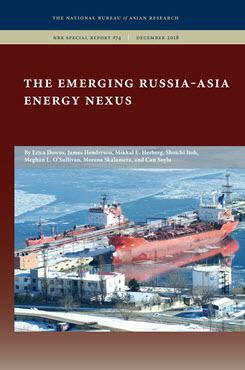Introduction: The Emerging Russia-Asia Energy Nexus
This is the introduction to the NBR Special Report “The Emerging Russia-Asia Energy Nexus.”
Russia possesses enormous reserves of oil, natural gas, and coal, and its size and geographic location put it in close proximity to some of the world’s largest energy importers. Japan, China, South Korea, and Asia’s other major energy importers have long sought greater access to Russia’s immense energy resources. Russian oil and gas supplies could significantly reduce these countries’ heavy dependence on energy imports from the Middle East, as well as their reliance on oil and liquefied natural gas (LNG) transported via the Indo-Pacific region’s congested and contested sea lanes.
Nevertheless, until recently, the results of Asia’s efforts to open up greater access to Russian oil and gas were relatively modest. Russia’s original energy “pivot” to Asia was slow and halting. In the wake of Western sanctions imposed on Russia in 2014 following its intervention in Ukraine, President Vladimir Putin announced with great fanfare that Russia would shift its future energy focus toward growing Asian and Chinese energy markets. It signed a major agreement with China to build a new gas pipeline from East Siberia to supply 38 billion cubic meters (bcm) per year beginning in 2018–19. Yet progress on building the pipeline was, until recently, agonizingly slow, and other official initiatives to expand energy ties moved just as slowly, if at all.
However, this has finally begun to change as Russia’s energy presence in Northeast Asia and elsewhere in the region has been quietly growing. Of course, Asia’s oil and gas importers have welcomed this development as an important opportunity to diversify their sources of both oil and natural gas, aiding in their enduring quest for energy security. But from a broader Western and particularly U.S. strategic perspective, Russia’s growing access to Chinese and other Asian capital, energy investments, and energy markets has potentially less welcome strategic implications that are not yet well understood by U.S. policymakers.
Russia’s expanding energy footprint in Asia is driven by the convergence of several underlying developments. First, conditions in the Russian energy industry are changing dramatically in ways that are opening up new avenues for energy exports to and investments in Asia, as well as new opportunities for Chinese and other Asian energy investment in Russia. Moscow began turning more urgently toward Asian, and particularly Chinese, energy markets because pressure from much lower oil and natural gas export revenues during the 2014–16 oil price crash, as well as from Western sanctions. Second, the consolidation of Russia’s oil industry under Rosneft, combined with the emergence of ambitious private companies such as Novatek, has added new dynamism to this push eastward.
The convergence of Russian and Asian energy interests has also been driven by major energy shifts in China. China’s relentlessly rising dependence on Middle East supplies has compelled Beijing to boost efforts to expand oil imports from Russia, which has now become China’s largest source of imported oil. China has now doubled the capacity of the Eastern Siberia–Pacific Ocean (ESPO) pipeline to transport Russian oil to northeast China, and its national oil companies have been given new equity energy investment opportunities in Russia that were impossible only a few years ago. At the same time, Beijing’s “dash for gas” to reduce coal use and fight air pollution has made the completion of the new Power of Siberia gas pipeline from East Siberia to northeast China a much more important priority. This dash for gas has also driven China’s major role in investment, financing, and offtake agreements to support completion of the Yamal LNG project spearheaded by Novatek. This dovetails with the growing potential for Russian LNG and oil shipments to China and Northeast Asia via the Northern Sea Route.
The picture is much more mixed for Japan, which is looking to encourage further expansion of the export capacity of Sakhalin Island LNG. The Sakhalin-2 project has been a key LNG supplier, and Exxon and Rosneft’s Sakhalin-1 project potentially has additional gas supplies that could be available. However, Japan is handicapped by its adherence to Western sanctions on Russia’s energy industry and by the historic legacy of their territorial dispute over the Northern Territories (known as the Kuril Islands in Russia). The picture is also mixed for South Korea. Its long quest to develop a natural gas pipeline project from Russia to offset its 100% dependence on seaborne LNG supplies remains blocked by its standoff with North Korea. On the other hand, there is some modest new momentum behind a potential undersea natural gas pipeline from China to South Korea possibly fed by Russian gas.
Russia’s growing role in Asia’s energy markets is likely to have important cross-cutting implications for both the region and the West. Greater access to Russian energy resources should significantly strengthen Asia’s energy security and help diversify the region’s import dependence. However, from a U.S. strategic perspective, Russia’s growing access to Asian, specifically Chinese, capital, investments, and energy markets has more problematic implications. First, it seems likely to strengthen Sino-Russian strategic alignment and regional collaboration, reinforcing other factors that are leading toward stronger cooperation between China and Russia. Also, access to Asian investment and financing is clearly giving Moscow a “relief valve” from Western sanctions and risks significantly undermining their effectiveness. More broadly, greater Northeast Asian energy alignment and integration with Russia could facilitate Asia’s potential shift to reduce its strategic dependence on the United States as doubts grow about the long-term U.S. commitment to the region.
With this in mind, the National Bureau of Asian Research (NBR) convened its 2018 Energy Security Program under the theme “The Emerging Russia-Asia Energy Nexus.” Now in its fourteenth year, NBR’s Energy Security Program convenes top geopolitical and energy experts from around the globe to produce an in-depth, twelve-month assessment of a major development in Asian energy markets to help policymakers better understand and respond to the implications for energy and national security. With generous support from Chevron and ConocoPhillips, and working in partnership with the Woodrow Wilson International Center for Scholars on a summer workshop, the 2018 program focused on a range of issues, including the evolving conditions in the Russian energy industry, the growing Russia-China energy connection, implications for Japan’s energy security and strategic position, and implications for the United States’ long-term strategic interests in Asia. An important goal of the program was bringing together policy, industry, and research leaders to better understand how to strengthen common approaches to strategic, economic, and energy concerns involving Russia and its energy ambitions in Asia.
NBR commissioned four essays by leading scholars to address key dimensions of the Russia-Asia energy nexus. The preliminary assessments were discussed at a workshop in Washington, D.C., on July 17, 2018, that included senior representatives from the U.S. and foreign policymaking communities and industry and geopolitical specialists.
In the first essay, James Henderson from the Oxford Institute for Energy Studies examines the new forces that are driving Russia to increase energy exports to Asia, and especially China. While Russia and China are what he calls natural “energy partners,” this dynamic is being reinforced by new geopolitical conditions. Most importantly, the U.S. and EU energy sanctions have accelerated the pace of Moscow’s pivot to Asia. The Kremlin has been encouraging its main energy companies, Rosneft and Gazprom, and more recently privately owned Novatek, to turn their attention east. Although strategic suspicions between Russia and China remain, a new balance is emerging between China’s strong bargaining position and Russia’s increasing ability to deliver oil and gas supplies. Russia also offers China potential long-term access to the Arctic. In the end, Henderson argues that oil and gas exports could become an important foundation for strengthening bilateral strategic ties over the next few decades.
In the second essay, Erica Downs from CNA assesses the growing energy nexus between China and Russia from the Chinese perspective. She argues that the key drivers have been China’s ability to provide large-scale capital for the major Russian energy companies at key junctures when they were under debt pressures or when access to Western capital markets was foreclosed by sanctions. In the case of oil, the China Development Bank provided huge loans in 2008–9 to Rosneft, making possible the construction of the ESPO pipeline to China. In the case of natural gas, Russia, and specifically Gazprom, were largely cut off from Western capital markets in the wake of sanctions in 2014. Russia looked to China as a key future gas market and provider of large-scale financing by signing the landmark agreement to build the Power of Siberia pipeline. In the case of LNG, China provided critical financing, equity investment, and offtake agreements for the Yamal LNG project when it faced severe financing constraints due to Western sanctions. In all these cases, China benefited strategically by diversifying its oil, natural gas, and LNG imports. Ironically, the recent U.S. tariffs have cast doubt on the extent to which China will be willing to rely on U.S. crude oil and LNG exports, thus further reinforcing Beijing’s incentives to strengthen strategic energy relations with Russia.
Next, Shoichi Itoh from the Institute of Energy Economics, Japan (IEEJ) examines Japan-Russia energy relations in the particular context of the unique and evolving relationship between President Vladimir Putin and Prime Minister Shinzo Abe. As Itoh notes, Abe has struck a markedly different tone in his outreach and prioritization of engagement with Russia from his recent predecessors and sees energy cooperation as a potential foundation for cultivating the necessary trust and common bond required to resolve the long-standing territorial dispute. Yet Itoh argues that this vision may border on “wishful thinking,” particularly once practical market realities are taken into account. Moreover, such cooperation may undercut efforts to deepen the already robust U.S.-Japan economic relationship, where cooperation on energy has been a key priority. While Itoh does not argue that Japan’s interests in closer cooperation with Russia and forging deeper ties with the United States are in fundamental opposition, he does conclude that these relationships will need to be closely managed.
In the final essay, Meghan O’Sullivan, Morena Skalamera, and Can Soylu from the Geopolitics of Energy Project at Harvard University’s Kennedy School of Government assess the implications of Russia’s growing energy role in Asia and the extent to which it is contributing to a broader strategic alignment with China. They argue that China and Russia are forging closer ties to build a multipolar world and that these energy ties are the foundation of the economic partnership. Yet China clearly still has the upper hand in the relationship. Moreover, although it has a strong interest in importing Russian oil and gas, its relationship with the United States remains far more important. The authors caution, however, that the aggressive U.S. stance toward trade with China inadvertently plays into Russia’s hands by potentially reducing China’s interest in importing U.S. oil and LNG and increasing the attractiveness of Russian oil and gas imports. This approach also undercuts Beijing’s strategic logic of keeping a distance from Russia to avoid complicating relations with the United States.
In conclusion, the emerging Russia-Asia energy nexus has significant implications for U.S. policymakers. On the one hand, it is strengthening the region’s energy security by providing diversification away from extremely heavy dependence on the Middle East. Clearly China has benefited the most so far, but over time the growing focus of Russia’s energy companies on Asian markets is likely to increase the supplies available to Japan, South Korea, and the rest of the region. On the other hand, energy trade and investment could lay the foundation for a closer strategic alignment between China and Russia that would challenge U.S. power and influence in Asia and globally. In this regard, the United States needs to think carefully about how its increasingly confrontational trade policy toward China has the potential to undermine U.S. exports of oil and LNG. Specifically, U.S. policymakers need to re-evaluate the important strategic role of energy exports in shaping the future of U.S. relations with China and Asia more broadly.
Mikkal E. Herberg
Research Director of the Energy Security Program
The National Bureau of Asian Research




